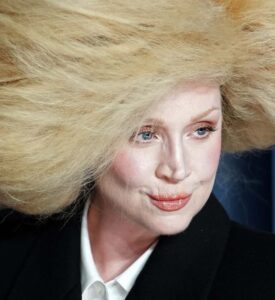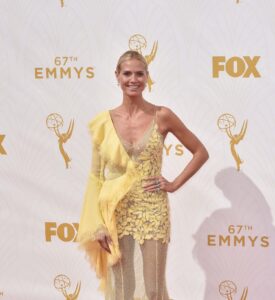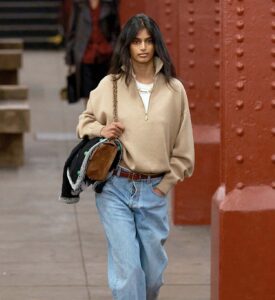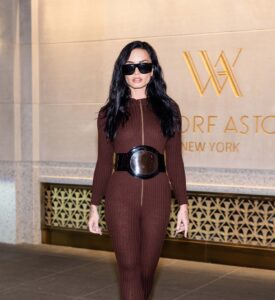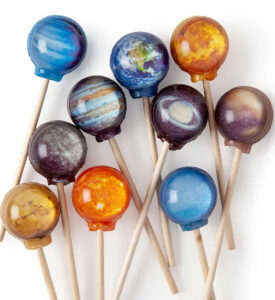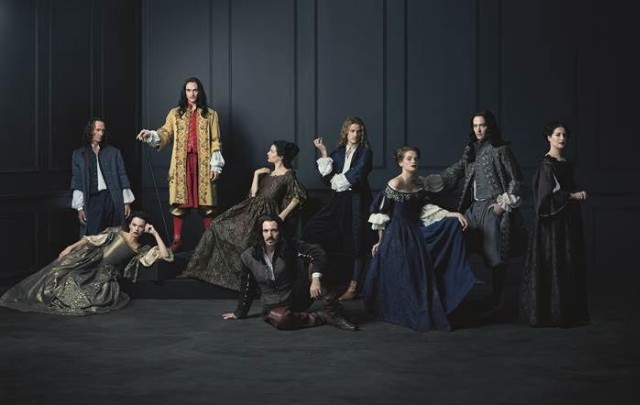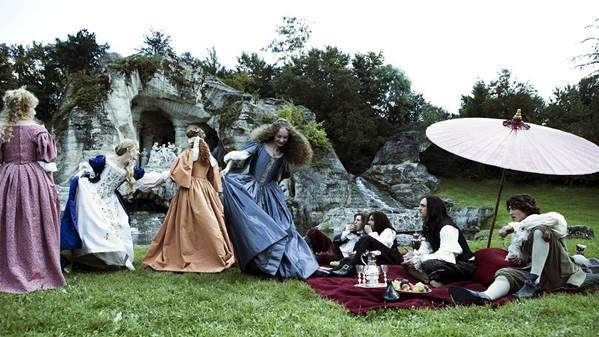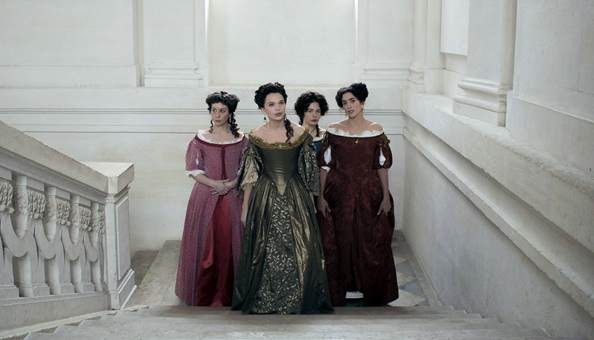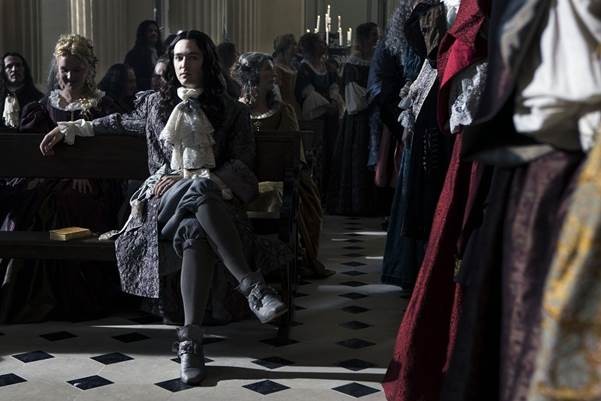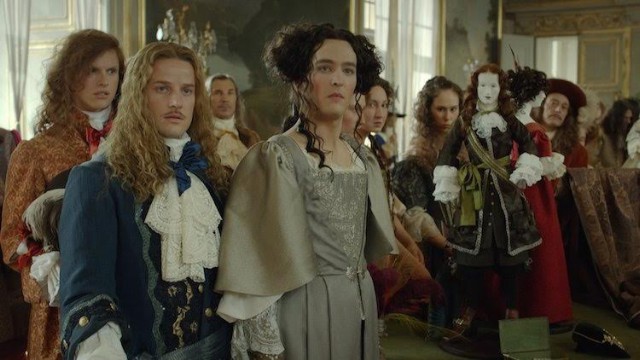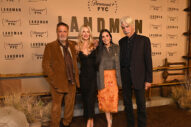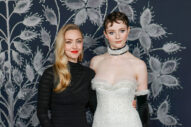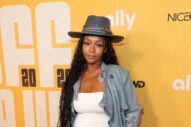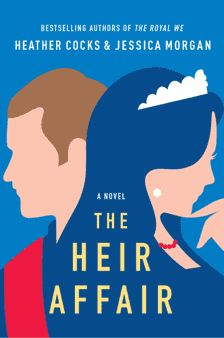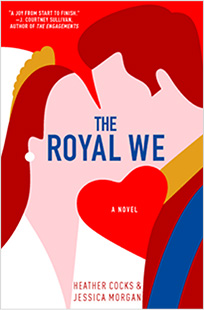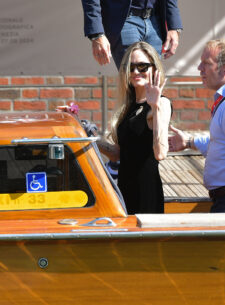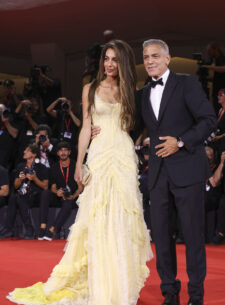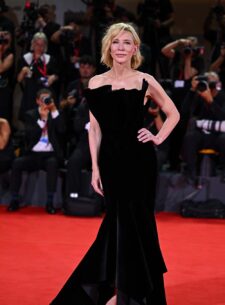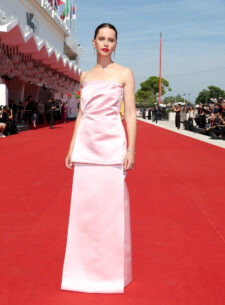Europe’s most expensive costume drama ever, Versailles, is premiering in the United States on October 1st on Ovation (last week, we gave you a sneak peek at its costumes and trailer). We were delighted to get a chance to quiz its costume designer, Madeline Fontaine, via e-mail, about her experience recreating the sumptuous and complex world of the the Sun King. Fontaine’s resume is highly impressive — in addition to Versailles, she was the costume designer for Amelie, Yves St. Laurent, and the upcoming Natalie Portman flick Jackie, and has won two César Awards. In short: She knows her stuff.
GFY: Let’s jump in with the lovely Versailles. How did you get involved with this particular project?
Madeline Fontaine: I was invited to collaborate by the set designer Katia Wyszkop. How I did I immerse myself in the period and in the project? Like any other subject, it needs a time of “feeding” — made of visuals (paintings, for these days) and readings, to feel what we can find to re-create the atmosphere of the period, and learn about all we can use to realize it. We collect the information and find the right crew for such a long project. Then we make sure all this information is recorded so it can be refined later.
GFY: When did you first join the team, compared with when they actually started shooting, and when you wrapped? How long an undertaking was this?
MF: For season one, it’s been a nearly full time investment for about a year. For season two, a lot of things were already settled and we had the experience of the first season. I was mainly involved in the beginning (how to use what we did already, jumping ten years, creating new silhouettes) and choosing the design and fabrics of the new pieces for the main actors, and the new ones.
GFY: A project like this obviously involves a great deal of research; the pressure for historical accuracy must be intense. How do you balance the desire to be accurate with the desire to create something that will be appealing to a modern viewer — or the desire to put your own stamp on something?
MF: I don’t think we had the mission to be historically perfect. I think we have to take both actors and public into a respectful feeling of a period, to make it believable and true, to use the reality of the body’s constraints which determined a language, adapting it to current physical ways of communicating and habits. The “stamp” is totally dependent of a sensibility, and cultural references, I think it cannot be hidden.
GFY: What are the traps people can fall into when costuming a project like this? Are there any?
MF: The impersonal copy of references could be a trap.
GFY: Could you take us through a typical day for you? What are some of the major duties that you have during a project, and how big a team do you supervise? How does something like Versailles compare to, say, Amelie?
MF: We always start with a small committee to determine the basis of the work, and the team grows to share the different aspects of the department charges. The workshop for Versailles went from four [people] to settle the prototypes, to thirty when the rush came when we finally had all the actors, scripts, and schedules. All the choices and decisions are under my responsibility, and I have to coordinate the crews (workshop and set) with an assistant. I need to be “inside” close to the “making” and outside to find the fabrics and details we need for the creations.
Versailles was bigger (in time and quantities) but it happens to be very similar on movies. The main differences [between movies and TV] are: We have the script in hand from the beginning, only one director, and continuity [is] easier to manage, [and you have] more time to shoot in movies than series. For Amelie we were such a small crew you wouldn’t believe it.
GFY: What is your favorite piece in Versailles?
MF: I don’t think I have one. We had the chance to experiment a lot, one driving to the next one.
GFY: And which piece was the most agonizing to create?
MF: The difficulties often come from imagination on paper — not so easy to manifest, but nothing impossible to resolve.
GFY: The textiles and notions you used are so lush and beautiful. How did you source them? Was there anything you simply could NOT find?
MF: It’s a kind of crisis for us. France used to be a place where beautiful and numerous fabrics were made. Times are changing for cheap and throw-away things. It is now difficult to find the fabrics we need.
GFY: What was your biggest challenge on this project? Related, is there anything you wanted to do, but weren’t able to? Is there anything you wish you could go back and do differently, or fix?
MF: The first dress of Philippe in season one. (Pictured below.)
GFY: How difficult is it to clear your mind of a project like this, or ANY project, in order to tackle the next one? And of course, how long a vacation do you need?
MF: It depends on the project, and it’s not only of our choice, sometimes projects you cannot refuse come too soon…. Of course, it takes time to find again the energy and the fervor to start a new project.
GFY: Do you mind telling us how you originally became a costume designer?
MF: As with many things in life, it came from encounters. I followed the art section, and was particularly drawn to textiles, but didn’t know it would be my professional life. I gave a hand to the costume designer of Un été meurtrier in 1982 and discovered at this occasion the profession and its attraction for me. Then I decided to learn by working with different designers.
GFY: We’re always so interested in how the clothes help tell the story, both in real life and in entertainment. When you start a project, how do you put yourself in that mind frame? How do you find the visual story you want to tell, and how much freedom do you have to tell it?
MF: It is the “fruit” of collaboration. It depends, first, on the vision the director has. We are in the project to interpret and propose directions to help the actors to bring the characters to life. It is a manifestation of the vision we have, and the one everybody (director and actors) will adopt as the proper one.
GFY: What’s the first project you truly felt you put your stamp on?
MF: I think you always work with your sensibility and reveal a part of it in the result. If you mean by “stamp” something like a signature, I would have to say Amelie.
GFY: It had such a wonderful and unique visual language. How much were you, and the costuming, involved in creating the overall vision? At what point did they bring you in, and how much did any of that change once Audrey was cast and your plans could be more specific to her?
MF: Of course, it is the choice of Audrey which influenced the silhouette of Amelie and her texture. We had been exploring with her and Jean-Pierre Jeunet this character, her colors, her universe — with the set designer Aline Bonetto too, obviously. The eye of the [director of photography, Bruno Delbonnel] is precious. We started — all of us — from the very beginning to delve into how the costumes would play into the vision.
GFY: You also worked on Yves Saint Laurent. What was it like to have to costume a character based on a man who, in a sense, costumed other people for a living? And for other characters and extras, did you have to dive deep into the YSL archives? Did you end up re-creating or using vintage?
MF: It was the challenge of this film for our department! We dived into the archives (as we always do, even if the archives can sometimes be very different). We made a mix of re-creation and vintage styles.
GFY: How much does the particular actor end up affecting what you decide to do? We mentioned Audrey Tautou, but you’ve worked with so many other memorable people in memorable roles over your career. Were there any costumes that were inspired or influenced as much by the person wearing them as the character?
MF: They are all inspired by the person on the way to the character.
GFY: Who are the mentors you’ve had in this business? The entertainment industry often gets a rep for being competitive and combative. Have you found that true in costuming?
MF: Jean-Pierrre Jeunet offered the opportunity to show my work in a better shop window, and it opened the way. A very important turn. Of course we find, as everywhere else, competition, but I refuse this way of living. I hope I created a good feeling of collaboration in our crew, that is very precious. We meet enough pressure. Better be happy inside the department, and it’s even more efficient!
GFY: What were the best and worst pieces of advice you were given when you entered the industry, and what advice would YOU give to someone who’s getting into it now?
MF: “The costume might never steal the first place when it’s not the purpose, it’s here to help the ‘incarnation’ of a character, and does not work for itself” was a wise transmission from my elders. I would tell the newcomers to be always curious and never stop learning, to stay far away from competition, and try to be at the best of what they can do.
GFY: As someone who understands the power of how clothes can tell a story, are you meticulous about how you wear them yourself?
MF: I do take care of the image I send, and I like the associations in life as on screen, but I’m not obsessed.
GFY: What is your dream project? What is next for you?
MF: A project which would make me dream! I don’t know yet.
If you enjoyed this interview with Madeline Fontaine, you might enjoy our interview with Kristin Burke, who was the costume designer for Sleepy Hollow, or our interview with Jeffrey Mossa, the production designer for The People vs OJ Simpson.
